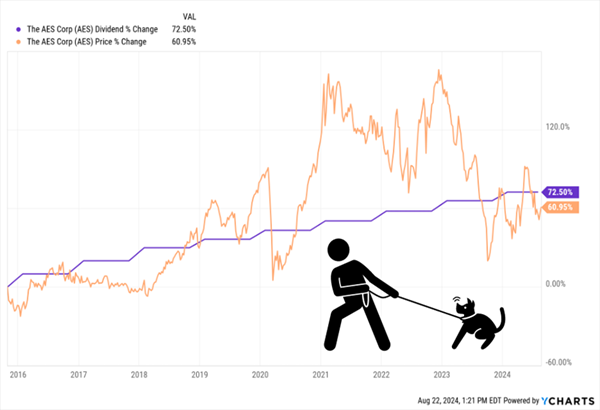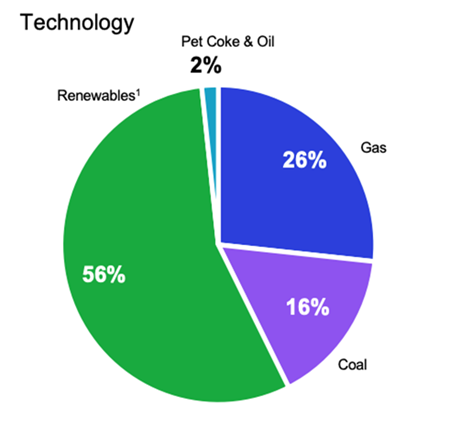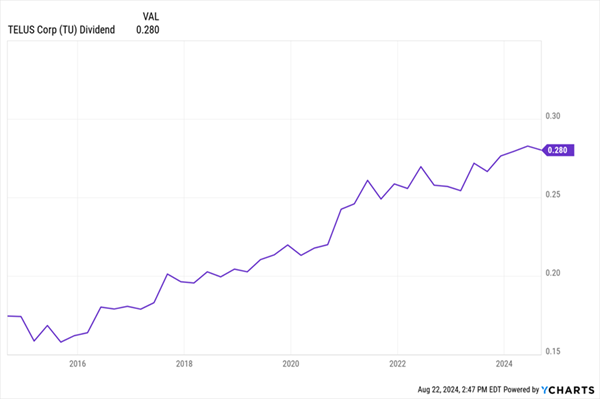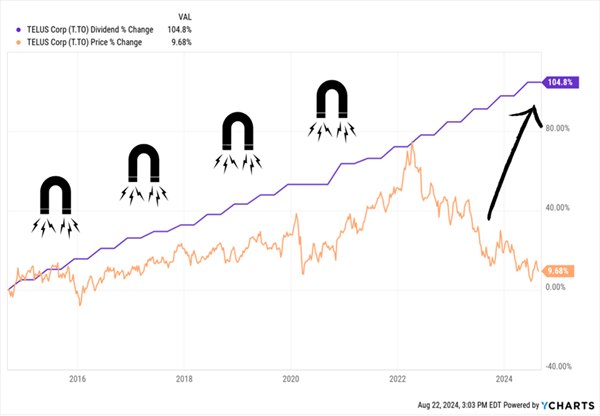If you’ve been watching utility stocks over the last few months, you might think our chance to buy these big dividends is history.
It’s not: There are two still sweet utility deals on the board, offering both high dividends (up to 7%) and steadily growing payouts. Why are these bargains still available? We’ll get to that shortly.
First, let’s talk about why utilities have been at the top of our buy list this year: When interest rates fall, “utes” fly.
Most people see utilities as bond proxies, which is why they got crushed when rates spiked in ’22. Why bother with even low-volatility utilities when you can get a guaranteed near-5% payout from a 2-Year Treasury?
But when rates fall, and that sweet Treasury income is off the table, people come running back to utilities. The result can be some shockingly big moves for a normally mellow sector. Consider American Electric Power (NASDAQ:AEP), which we bought in the February issue of my Hidden Yields service.
Man, a lot has changed since then.
Back in late February, we’d just gotten a hotter-than-expected CPI report, and the inflation boogeyman returned. The media fretted that, after all those rate hikes, the Fed would fail to “stick the landing,” as Bloomberg cleverly stated:
We didn’t buy it. The Fed clearly had rates in restrictive territory, so it was a question of when, not if, inflation would drop.
Six months on, inflation is at 2.9%, the high end of the Fed’s target range. And Jay Powell flat-out told us rate cuts are now ahead from the Fed’s Jackson Hole confab on Friday. And the so-called “long rate”—the yield on the 10-year Treasury note, has dropped from 4.3% to around 3.8% as of this writing.
American Electric? It’s up a tidy 22.7%—a titanic move for a utility. Plenty of utilities have done the same, and to be honest, we see most as holds now (including AEP). But as I said, there are still a couple that have been overlooked.
The first one is a US firm with considerable operations beyond America’s borders. The other is a telecom stock based in Canada—a country where just three companies rule the wireless roost. And Canadians, like Americans, are not going to cut their cell phone use, recession or no.
Utility Bargain No. 1: AES Corp. (AES)
AES Corp (NYSE:AES). yields 3.9% as I write this, and its dividend does what you’d expect from a steady-as-she goes business like this: It steadily grinds higher.
Check out the slow ’n’ steady staircase of payout hikes over the last nine years (through rising rates, falling rates and the pandemic), as well as the effect that payout growth has had on the share price.
Let’s Buy as AES Pulls On Its “Dividend Leash”

Just like a poorly behaved dog on a leash, the stock price (in orange) sometimes jumps ahead of the payout and sometimes falls behind. But ultimately it comes right back to the purple line. Right now it’s behind—a sign that AES is undervalued.
You can also see in the chart above that AES is well off its recent peak, which it hit in May, even though 10-year Treasury rates have dropped since.
That may be because AES operates in a number of markets beyond the US, such as Brazil, Mexico, the Netherlands and the UK, making it a bit harder for first-level investors to value than a purely domestic player like, say, Duke Energy (NYSE:DUK) or Southern Co. (NYSE:SO).
Investors may also still be smarting after being clipped by the “dollar bulldozer”: the high greenback of the last few years. But lower rates will weigh on the buck, making AES’s sales worth more. We’ve already seen it soften this summer.
AES is also targeting growth in renewable energy, with 56% of its 35,632 megawatts in operation coming from hydro, solar, wind and landfill gas, as well as the battery capacity needed to store power from those sources.
Source: AES Corp. Q2 fact sheet
That’s just plain smart, business-wise: According to a 2023 study by the International Renewable Energy Agency (IRENA), 86% of renewable capacity that came online in 2022 was cheaper than fossil fuel–generated power.
Moreover, AES continues to position itself as a leading electricity provider for data centers, which are feeding the power-hungry development of AI.
In the second quarter, for example, management said it signed agreements for 1.2 gigawatts to power data centers and is in talks for three more gigawatts.
Plenty of pundits have been touting utilities as a “back door” play on AI. To be honest, I’m a skeptic: Interest rates are a far bigger driver for utility stocks. But it is still nice to see AES going after this growing source of demand.
Utility Bargain No. 2: Telus Corp. (TU)
Canadian telco Telus Corp (NYSE:TU) yields 7% as I write this. But if you look at its dividend chart, it’s not nearly as steady as AES’s staircase:
“Loonie” Dividend Masks Payout Stability …

Nope, this is not a series of random cuts and hikes. It’s entirely due to currency fluctuations (Telus, by the way, conveniently trades on the NYSE under the TU symbol). But a lower US dollar means the Canadian “loonie”—slang for their currency—would convert to more greenbacks for us.
And when you look at the dividend in Canadian currency (along with the direction of the share price) you see that Telus’s “Dividend Magnet” was keeping the stock moving up until interest rates (in the US and Canada) spiked in 2022, sending the shares tumbling.
… While the Canadian-Dollar Payout Points to Upside

Now that rates are set to become a tailwind (the Bank of Canada has already cut twice and will likely do so again in September), I expect that share price to trend back up.
Beyond that, Telus benefits from the fact that the Canadian cellphone market is essentially an oligopoly, with Telus, BCE Inc. (NYSE:BCE) and {{0|Rogers}} Communications (NYSE:RCI) controlling a bit less than 90% between them. That state of play has existed, more or less, for years (with slightly more of the market going to regional carriers these days).
That gives these firms stable revenues to fuel their dividends. Telus, with its tighter focus on wireless and home Internet access, is also profiting from the rapidly growing Canadian population, as management noted in its second-quarter earnings report.
Finally, lower rates will help cut borrowing costs in the long run, and make the company’s high-yielding (and growing) payout more attractive to income-seeking investors.
Urgent: More “Recession-Resistant” Dividends to Buy Now
Utilities (especially cheap utilities!) like Telus and AES are among our favorite “recession-resistant” stocks to buy, for a simple reason: Their revenues hold up no matter what the economy does.
If you think the Fed is likely to keep rates too high for too long, pushing us into a recession (a setup I see as likely), you’ll want to make sure you have “ironclad” utilities like these in your portfolio.
AES and TU are just the start. Right now, I’m pounding the table on 5 other “recession-resistant” plays throwing off high, and growing, dividends now, like:
- A REIT that “rents out” cell-towers to companies like Telus. This one yields 6.1% and has hiked its payout a fit 39% in the last five years.
- A natural gas stock trading for a silly 6-times free cash flow, thanks to “natty’s” (temporary) drop to around $2. This stock is poised to generate $14 billion in free cash flow in the next five years, much of which will find its way into its dividend payout.
These are two of the five stocks I’ve put into my “Recession-Resistant” portfolio, which I’m ready to share with you now.
Disclosure: Brett Owens and Michael Foster are contrarian income investors who look for undervalued stocks/funds across the U.S. markets. Click here to learn how to profit from their strategies in the latest report, "7 Great Dividend Growth Stocks for a Secure Retirement."
